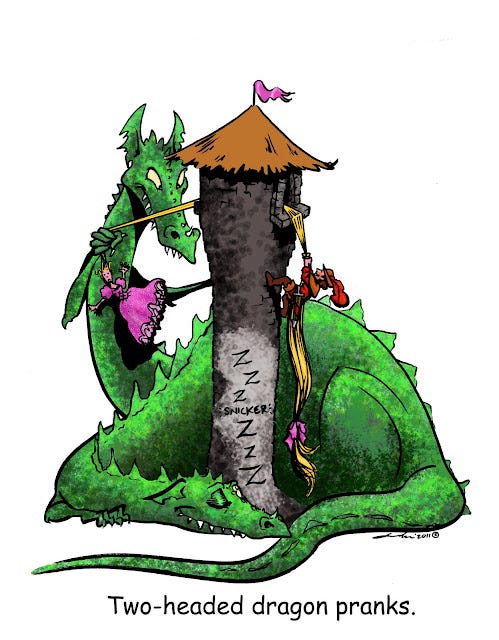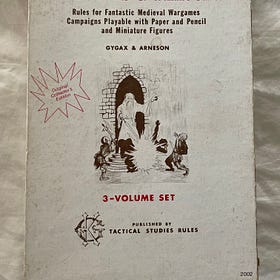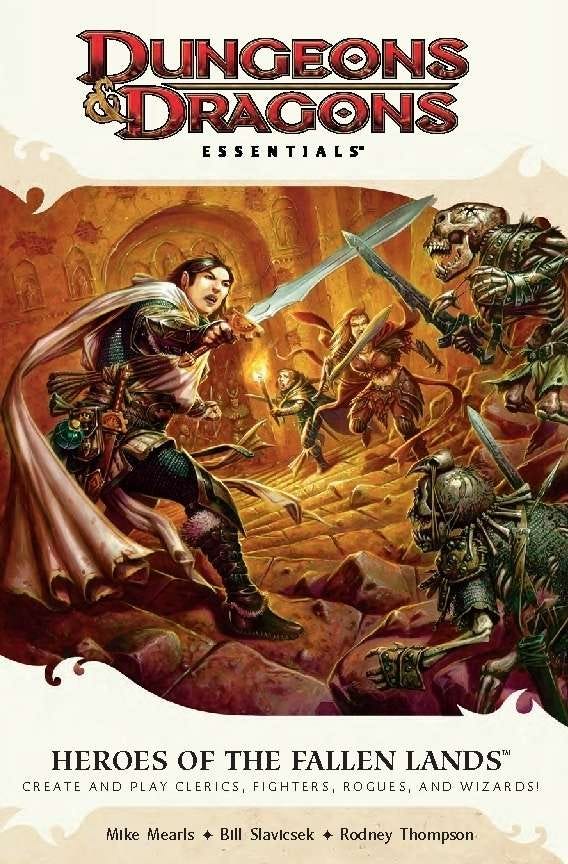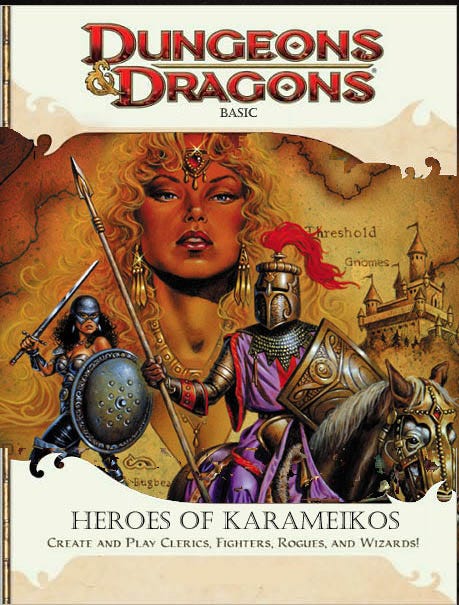Do You Even Fantasy Heartbreaker Bro?
In my most recent Weekly Geekly Rundown, I mentioned that I worked on a Fantasy Heartbreaker called The Secret Fire and
has expressed an interest in learning more about this game. All these years later, I’m still very proud of the game we put together. I think we could have deviated even more from the Open Source Document for the 3.5 Open Gaming License because I think the ways we pulled away from that were the spaces where really interesting design happened.So what is a Fantasy Heartbreaker and what’s the story behind The Secret Fire? Let me tell you a tale of the times when Tigers Used to Smoke.
What is a Fantasy Heartbreaker?
In 2002, Ron Edwards wrote his now famous (infamous in some gaming circles) article about how some fantasy role playing games broke his heart. The article discussed how there were a number of designers in the 80s and 90s who were creating “deeply personal games” that took existing systems and added house rules to them to create something that was an example of the DIY spirit. Ron Edwards talked about how he loved these games, but how the designers didn’t understand the role playing game market. The designers were producing large offset printed tomes in print runs in the low thousands. These were expensive games doomed to failure because they were too narrow for the mainstream.
It didn’t take long for many in the indie community to completely miss his point and to use the term as a pejorative that meant “lazy D&D ripoff.” To transform what was a term of empathy into a snide and dismissive insult demonstrated the cruelty of some members of role playing game critical culture.
This critical cruelty led Edwards to write a follow up essay clarifying the issue, and where he added a couple more games to his list of fantasy heartbreakers. After this compelling and heartfelt clarification, people continued to misuse the term and Fantasy Heartbreaker is still primarily used by people as an insult implying a game is a “lazy D&D ripoff.”
To be fair, there is some small truth to the lazy D&D ripoff insult. Most of the Heartbreakers from the 80s and 90s took D&D as their launching off point. There is a difference between Runequest and Fifth Cycle, even though both are spin-offs of D&D. Runequest spun-off as a natural extension and refinement of the “Perrin Conventions.” The Perrin Conventions were a collection of house rules that can be found in Chaosium’s All the Worlds’ Monsters Vol. 2. These rules added a number of interesting twists on D&D, twists that eventually formed the basis for Steve Perrin’s design work on Runequest. Fifth Cycle differs from D&D in many of the same ways that the Perrin Conventions do, but it is as if someone took that list of changes and turned them into an entire game. Runequest started with that foundation and expanded into its own game, a game that had very little in common with D&D by the time it made its way through development. As personal as Runequest was as a game, in the end it was a fully professional product. In fact, for its era it was far above the norm in production value. Fifth Cycle on the other hand was rougher in design and less play tested. It’s more personal and less commercial. It’s that personal element that makes you root for the game, but it’s the lack of professionalism that breaks your heart.
Fantasy Heartbreakers and Me.
Like Edwards, I like a lot about Fifth Cycle and other Fantasy Heartbreakers. Part of that comes from the fact that I too have worked on a Fantasy Heartbreaker. It wasn’t my own personal Heartbreaker, I’m working on one of those right now in a public way. Though I haven’t updated it recently, I am developing the game in a way that is more in line with the modern publishing/communication principles Edwards suggests that the old Heartbreakers ignored. The game I worked on was a Fantasy Heartbreaker of a friend of mine named George Strayton. That game is The Secret Fire and I love it.
The Oldest RPG I've Played
I’ve mentioned that my first role playing game experience wasn’t a good one and that it’s kind of amazing that I love the hobby as much as I do, but I do love the hob…
I’ve mentioned my work in this game in a prior post where I discuss how George Strayton got me interested in Original D&D and how he brought me in on the “Secret Fire” project, but I wanted to elaborate a little bit more. The story is connected with my, and my wife’s time, at USC and the friends we made there and is a demonstration of how wonderful and sharing the “entertainment industry” can be.
Building a Game Community
When my wife and I moved to Los Angeles after undergraduate so that she could attend USC’s School of Cinematic Arts, I also started taking courses at the school in the School of Politics and International Relations. I applied to the graduate program at the same time Jody did, but through a series of bizarre events the University accepted me as well. I started my graduate school journey there, but I was not ready for the experience. It was still only a few years after my mom had died and when October 7th arrived I was a wreck. Add to that the fact that I had also applied, and been accepted at another program that I thought better suited me, and I ended up leaving USC and moving to the other program.
However, during my time at USC I had the wonderful opportunity to meet three people. The first was an undergraduate named Nick Santillan. I met him when I was working at USC’s remote education program as a TV switchbox operator. We had a ton of fun working the Kalypso series instruments as professors taught engineers watching the lectures via cable “broadcast.” We would produce the episodes within the parameters the professors desired, but we’d sometimes have a little fun with the inserts to make things more lively. We didn’t do anything that would distract the students or get us in trouble, but when the lectures were over we played around with the capabilities.
Nick introduced me to two other soon to be very close friends, Wes Kobernick and Joel Allan. Wes was a film school student and Joel was attending the Law School. Together, we all shared a love of Dungeons and/or Dragons and we played the game regularly. In fact, prior to Covid I was still playing D&D with Wes and Joel on a regular basis and attending Joel’s annual Superbowl party. We started playing as a group with 3rd edition, but eventually we moved on to 4th edition when it was published.
We had a great time playing 4th edition, a version of the game I liked so much that I started running “Encounters” sessions at the local game store. These sessions led to other life long friends and let me see D&D through the eyes of an entirely new generation. I had a particularly great time running the Keep on the Borderlands, Lost Crown of Neverwinter, and The Elder Elemental Eye adventures. I can still here James, one of the players in the Encounters crew, shouting “ZUBERON PIKE!” as he held shut the door that would open to the spaces between and allow the Abyssal Plague to spread over the world. Even better was the moment the party’s Hunter (a subclass of Ranger) pushed one of the villains into a well and then began shooting arrows at him. This gave rise to our inside joke, “as easy as shooting Dwarves in a well.” While 4th edition has its controversies, and deserves more than half of them, I still think that the Essentials version of D&D is my third favorite edition of the game after BX/BECMI and AD&D 2nd.
Which is the perfect segue into how I came to work on The Secret Fire. Wes, who was a part of both my monthly home game and weekly Encounters games, was also playing a game with a screenwriter named George Strayton who had worked on the Hercules and Xena series and wrote the screen play for the Dragonlance: Dragons of Autumn Twilight animated film. He also wrote a lot of content for West End Games’ Star Wars Role Playing game and was a part of West End Games’ bullpen who designed a lot of the former canon that Star Wars fans are mad at Disney for excluding.
As an aside, as with 4th edition D&D, there are a lot of people who dislike the Dragonlance animated film, but I am a fan of the film for a variety of reasons. I’ll be one of the first to admit that it is far from perfect. The animation is very uneven and the story skips moments I’d have liked to have seen explored more. Some people who are critical of the film will often say, “this is what happens when Hollywood and people who don’t care about a property make a film.” They’ll say this as if it was the fault of some studio head. They are exactly wrong. This is the kind of film you get when real fans, who can only get a limited budget, attempt to make an ambitious project based on a product they love.
The reason I’m a fan of the film is that it is sincere, even as it fails to attain the heights the creators hoped. Will Meugniot, the director, has a vast and highly credible resume in animation and he loves D&D. George Strayton, the screenwriter, is a gamer’s gamer and a HUGE Dragonlance fan. The casting for the film is spot on with Michael Rosenbaum as Tanis, Lucy Lawless as Goldmoon, Michelle Trachtenberg as Tika, Kiefer Sutherland as Raistlin, and Neil (Bonecrusher from Transformers and so much more) Ross as Fizban. Cindi Rice, one of the Co-Executive Producers on the movie, was an editor at TSR during the AD&D 2nd edition era and edited books in the Ravenloft and Forgotten Realms book lines. The makers were fans who cared about the project. It’s a flawed project, but like Dragon*Strike is one I’ll watch regularly in solidarity with fellow geeks.
Original D&D and Heartbreaker Development
It was during one of our regular gaming sessions that Wes mentioned that he played in a regular game with George Strayton and that he was an awesome DM because he ran sessions of Original D&D, sessions of 3rd edition, and 4th edition, as well as a version of D&D that combined old school and new school elements. It was at this point that I knew I’d have to try to play in a game session. I’ve always wanted to play in an Original D&D White Box game and this was going to be my opportunity.
When I was a kid there was a local toy store, not a Toys R Us, but a locally owned toy store similar in layout and cleanliness as those local hardware stores with “knowledgeable staff” that exist in cities of a particular size. It was a kind of dimly lit and dusty place that had a lot of new inventory and in the back of the store in some forgotten corner was a White Box with the words “Original Collector’s Edition” on it and a price tag of $10. That was a cheap price, but I didn’t have $10 to my name and I wanted it so bad I could taste it.
Every day, for a month, on the walk home from school I would wander into the back of that store, look at that little boxed set, and contemplate how to steal it. Should I use my backpack? Should I try to stuff it under my sweater? Should I just grab it and walk like I already paid for it? I knew I couldn’t afford it and my parents had just moved to the Bay Area and were strapped trying to afford the increased cost of living and save up for the first and last month’s rent on a good place (we were staying with a friend of my parents at the time). We did not have that kind of money. For a month, my temptation continued until my parents and I moved from our temporary residence to a more permanent one that was a few cities over. No longer was temptation lurking in the shadows of a toy store on the way home from school. I had been saved by circumstance from getting caught, I would certainly have been caught, and paying the consequences.
That was the one and only “chance” I had to own the White Box before I became an adult. I certainly never thought I would actually play in a White Box D&D game. When Wes mentioned George’s game, I waited exactly negative five minutes before I asked to meet George and I eventually got the chance. HE gave me a link to one of the rules sets they were using, a single volume version of the White Box rules, and I finally got the chance to play the game as originally written…or at least a semblance thereof. I also found a copy of the White Box, and a number of expansions, for sale on eBay for a very affordable price. It wasn’t $10, but it was far from market premium. I had my white whale. Oh, and I was able to purchase the pdf from DriveThruRPG too.
Do you even Fantasy Heartbreaker, bro?
My chats with my friend and the screenwriter eventually let to me working on a Fantasy Heartbreaker that fused old school (0e and Moldvay/Cook) design with 4e innovations. As you know by now, that game is the Fantasy Heartbreaker called The Secret Fire. Working on the game was a great experience and I am honored to have my name in the credits as a designer. I made some pretty specific contributions to the game in the initiative system and the racial “traits” system and think it is a really fun adaptation of old school rules. One of my favorite design choices was the racial traits system where we created “Some X” charts for the different backgrounds, racial and class based. These individualized how characters understood their and other character’s backgrounds. Take a look at the “Some Dwarves” chart below. This would be rolled by a Dwarven character to help them play their character, but the result is something that is only true of “some” Dwarves and not all. It’s something I’ve liked to incorporate into all my later game play and our use predates 5e. One of the takeaways I have from this experience is that working on a Fantasy Heartbreaker is something I think everyone should do at one time or another.
Like the Dragonlance film this was a deeply personal work for George (and for me). He was channeling all of his ideas for how to run a fun and engaging role playing game the connected both with older and newer gamers into a single product. I think his use of specific adjective descriptions for different attribute levels is genius. It’s a wonderful way to address metagaming by using adjectives to describe capability, rather than numbers. The labels are dated, the game was made in 2011, but the concept is sound. Instead of saying your character has a 13 strength with a +1 bonus, you say that your character is “Muscular.” It’s the same thing, but it’s more immersive. Similarly, the initiative system I worked on combines individual and group initiative and is fun to use in play. Essentially and PC can switch initiative with any other PC which encourages more teamwork without requiring narrowly defined actions like some versions of D&D.
The game is still VERY D&D influenced, but so too are the vast majority of OSR games published right now. For every Cepheus (a Traveller based OSR game) there are 20 games similar to Old School Essentials (I’m highlighting it because I LOVE it). What makes The Secret Fire, and not those other games, a Heartbreaker is that George, I, and everyone else followed a traditional publishing and marketing strategy. This strategy was doomed to fail. I think the game is fun and strong, but it would have been more successful if we’d built community first and then moved onto marketing. Marketing speak doesn’t go over well any more, but sharing and building community do.
That said, the energy and time we put into the game wasn’t wasted. It was productive and resulted in a game I think we can be (mostly) proud of making. That energy is what drives the current, and long lasting, OSR boom. The OSR movement is nothing but a vast conspiracy of Fantasy Heartbreaker designers making games, but making them with an understanding of how the market works. To say OSR doesn’t even always mean D&D, though it once did. There is the Cepheus series I mentioned, but there are also Call of Cthulhu inspired games, Chill inspired, and Marvel FASERIP inspired games. What’s great is that these games are often more than copies of those past games, they are refinements with years of playtesting behind them.
They are the lifeblood of the role playing game hobby and they will continue regardless of what Hasbro does with D&D. In fact, the worse Hasbro abuses the D&D fanbase, the bigger the Fantasy Heartbreaker movement will become. Yes, it will be a long tail movement where money is made on the margins, but when the creation is DIY overhead is low so profits come with even moderate revenue streams.
This energy is why I’m working on a D&D variant that combines 4e and BX called Heroes of Karameikos. It’s also why I will be working on a retroclone and improvement of Superhero 2044. It was the first superhero role playing game and it has a great core resolution system. What it lacks is a character design system and I’m up for that. I’ve really got to finish Heroes first though.










Great post! Your "some dwarves" approach reminded me of Robert Anton Wilson's "sombunall" ("some but not all") concept.
I think now more than ever is a great time for game designers to take chances with heartbreaker rpgs. At the very least, it's an exercise in game design and they can release with with little fuss and low stakes with any of the self-publishing options that are out there. If they wanted to make it into something more, gaming communities are quite active, time permitting, and the continual feedback can genuinely help creators develop their heartbreakers into games that balance the professional and personal aspects of the industry.
I have two (or three) systems that I've lamented not dedicating enough time to writing since I graduated from my master's program (as most of my writing has been Substack this past year and a half!) but I at least know there are still places I can turn for help and advice when I am ready to share them for playtesting or editing.
I also find it funny whenever I see complaints about Hasbro's D&D online, as I feel like this newer wave of players can't really fathom the idea that they don't need the rulebook or can just play other games of their own devising.